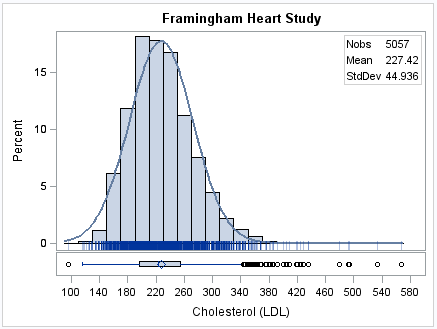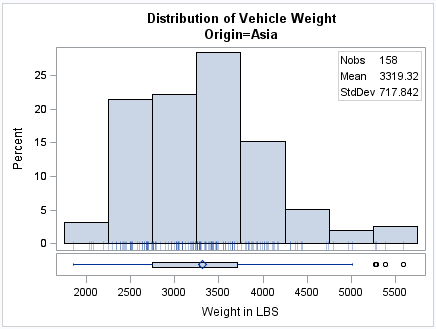SGRENDER Procedure
Example 2: Defining Dynamic Variables
| Features: |
DYNAMIC Statement |
| Sample library member: | SGREND1 |
This example uses dynamic
variables to set values within the StatGraph template. By using dynamic
variables to set the variable names, variable labels, and other parameters,
the StatGraph template can be used with different data sets.
The second PROC SGRENDER
statement generates multiple graph for the CARS data set by using
BY grouping.
Program Template and Heart Data
proc template;
define statgraph distribution;
dynamic VAR VARLABEL TITLE NORMAL _BYLINE_;
begingraph;
entrytitle TITLE;
entrytitle _BYLINE_;
layout lattice / columns=1 rows=2 rowgutter=2px
rowweights=(.9 .1) columndatarange=union;
columnaxes;
columnaxis / label=VARLABEL;
endcolumnaxes;
layout overlay / yaxisopts=(offsetmin=.035);
layout gridded / columns=2 border=true autoalign=(topleft topright);
entry halign=left "Nobs";
entry halign=left eval(strip(put(n(VAR),8.)));
entry halign=left "Mean";
entry halign=left eval(strip(put(mean(VAR),8.2)));
entry halign=left "StdDev";
entry halign=left eval(strip(put(stddev(VAR),8.3)));
endlayout;
histogram VAR / scale=percent;
if (exists(NORMAL))
densityplot VAR / normal( );
endif;
fringeplot VAR / datatransparency=.7;
endlayout;
boxplot y=VAR / orient=horizontal;
endlayout;
endgraph;
end;
run;
proc sgrender data=sashelp.heart template=distribution;
dynamic var="cholesterol" varlabel="Cholesterol (LDL)" normal="yes"
title="Framingham Heart Study";
run;
title;Program Description
proc template;
define statgraph distribution;
dynamic VAR VARLABEL TITLE NORMAL _BYLINE_;
begingraph;
entrytitle TITLE;
entrytitle _BYLINE_;
layout lattice / columns=1 rows=2 rowgutter=2px
rowweights=(.9 .1) columndatarange=union;
columnaxes;
columnaxis / label=VARLABEL;
endcolumnaxes;
layout overlay / yaxisopts=(offsetmin=.035);
layout gridded / columns=2 border=true autoalign=(topleft topright);
entry halign=left "Nobs";
entry halign=left eval(strip(put(n(VAR),8.)));
entry halign=left "Mean";
entry halign=left eval(strip(put(mean(VAR),8.2)));
entry halign=left "StdDev";
entry halign=left eval(strip(put(stddev(VAR),8.3)));
endlayout;
histogram VAR / scale=percent;
if (exists(NORMAL))
densityplot VAR / normal( );
endif;
fringeplot VAR / datatransparency=.7;
endlayout;
boxplot y=VAR / orient=horizontal;
endlayout;
endgraph;
end;
run;Program for Grouped Cars Data
proc sort data=sashelp.cars out=cars; by origin; run;
proc sgrender data=cars template=distribution;
by origin;
dynamic var="weight" varlabel="Weight in LBS"
title="Distribution of Vehicle Weight";
run;
title;Program Description
Sort the SASHELP.CARS data set. The data set must be sorted by the same variable
that the following PROC SGRENDER block uses in its BY statement.


